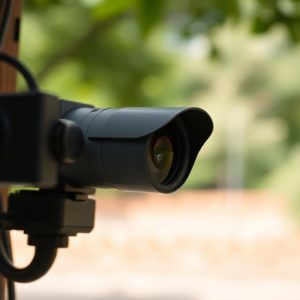Optimizing Home Security: Tiny Cameras and Advanced Sensor Detection
Optical sensor technology has made Tiny Cameras for Home Monitoring a game-changer in residential se…….
Optical sensor technology has made Tiny Cameras for Home Monitoring a game-changer in residential security. These miniature devices, with high-resolution imaging and AI-driven analysis, offer discreet yet comprehensive surveillance. Wireless data transmission to mobile devices provides remote access and peace of mind. Professional installation and best practices ensure optimal performance, accuracy, and privacy preservation. 3D sensing technologies further enhance capabilities, making tiny cameras essential for modern home security protocols.
Optical sensor technology revolutionizes home monitoring, offering advanced security solutions with tiny cameras that discreetly integrate into everyday environments. This article explores the benefits and professional implementation of these innovative systems, focusing on optimal sensor detection sweeps. From understanding core technology to best practices and advanced optimization techniques, we delve into how tiny cameras enhance home security, ensuring comprehensive coverage while maintaining a sleek, unintrusive design.
- Understanding Optical Sensor Technology for Home Monitoring
- Advantages of Using Tiny Cameras in Home Security Systems
- Professional Implementation Methods and Best Practices
- Advanced Techniques for Optimizing Sensor Detection Sweep
Understanding Optical Sensor Technology for Home Monitoring
Optical sensor technology has revolutionized home monitoring, making it more accessible and efficient than ever before. At the heart of this revolution are tiny cameras designed to fit discreetly into homes, offering a comprehensive view of your surroundings. These miniature devices pack advanced optical sensors that capture high-resolution images and videos, ensuring clear visibility even in low-light conditions.
By integrating these tiny cameras for home monitoring, homeowners gain a powerful tool for security and surveillance. They allow real-time observation of various areas within the house, enabling quick response to potential issues or intrusions. Moreover, the data collected by these sensors can be transmitted wirelessly to mobile devices, providing remote access and peace of mind.
Advantages of Using Tiny Cameras in Home Security Systems
The integration of tiny cameras into home security systems has brought about a significant evolution in residential surveillance. These miniature yet powerful devices offer numerous advantages for homeowners seeking robust and discreet security solutions. One of the key benefits is their versatility; tiny cameras can be strategically placed almost anywhere, from windowsills to doorframes, providing an extensive monitoring network without compromising aesthetics. This comprehensive coverage ensures that potential intruders are deterred by the very presence of these unseen sentinels.
Additionally, these cameras enhance security by enabling round-the-clock observation, allowing homeowners to stay alert and responsive to any unusual activities. Their compact size facilitates easy installation, making it a convenient option for do-it-yourself enthusiasts looking to bolster their home’s defenses. With advanced technology, tiny cameras for home monitoring deliver crisp images and video footage, even in low-light conditions, ensuring that every detail is captured and can be reviewed later if needed.
Professional Implementation Methods and Best Practices
Professional Implementation Methods and Best Practices
The implementation of optical sensor detection systems, particularly tiny cameras for home monitoring, requires careful planning and execution to ensure optimal performance and security. Professionals in this field often employ advanced methods such as strategic camera placement, utilizing high-resolution sensors, and integrating the system with a robust network infrastructure. This ensures that every angle is covered, providing comprehensive monitoring capabilities without compromising privacy.
Best practices involve regular calibration and maintenance checks to keep the systems accurate and reliable. Encryption and secure data transmission protocols must be implemented to protect sensitive footage. Additionally, professionals recommend discretely positioning cameras to avoid drawing attention while still achieving clear, unobstructed views. This subtle approach maximizes the effectiveness of tiny cameras for home monitoring, offering peace of mind without sacrificing aesthetics or privacy.
Advanced Techniques for Optimizing Sensor Detection Sweep
In the realm of home monitoring, tiny cameras have revolutionized security measures with their discreet and efficient capabilities. To optimize sensor detection sweeps using these miniature devices, professionals employ advanced techniques. One such method involves integrating AI-driven image analysis to enhance accuracy in identifying movement and objects within frames. By training algorithms on vast datasets, these systems can differentiate between genuine threats and false positives, minimizing nuisance alerts.
Additionally, the utilization of 3D sensing technologies, like LiDAR and time-of-flight (ToF) sensors, offers a multidimensional perspective. This enables more precise mapping of environments and better object recognition, especially in low-light conditions or through obstacles. Such innovations ensure that tiny cameras for home monitoring not only provide comprehensive coverage but also deliver dependable, real-time alerts, making them indispensable tools for modern security protocols.
Optical sensor technology, particularly tiny cameras for home monitoring, has revolutionized home security systems. By understanding these sensors’ capabilities and implementing professional methods like optimized sensor detection sweeps, homeowners can ensure comprehensive protection. The advantages of integrating tiny cameras are clear, from enhanced visibility to advanced analytics. As this field continues to evolve, adopting best practices will safeguard homes in the ever-changing digital landscape.


